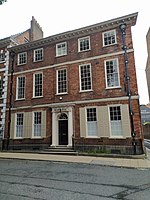Grand Hotel and Spa (York)
Buildings and structures completed in 1906Grade II* listed buildings in YorkHotel spasHotels in YorkUse British English from April 2023

The Grand, formerly the Grand Hotel and Spa, is a Grade II* listed hotel in York, England, the city's only 5-star hotel. Opened in May 2010 and renovated and extended in 2017–18, it is an Edwardian building dating to 1906, originally the headquarters of the North Eastern Railway, with views of the York city walls and York Minster. It is owned by Splendid Hospitality Group.
Excerpt from the Wikipedia article Grand Hotel and Spa (York) (License: CC BY-SA 3.0, Authors, Images).Grand Hotel and Spa (York)
Station Rise, York Bishophill
Geographical coordinates (GPS) Address Phone number Website Nearby Places Show on map
Geographical coordinates (GPS)
| Latitude | Longitude |
|---|---|
| N 53.958841666667 ° | E -1.089175 ° |
Address
The Grand Hotel & Spa
Station Rise
YO1 6GD York, Bishophill
England, United Kingdom
Open on Google Maps











